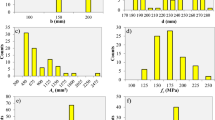Abstract
Because the behavior of HPC at early age may be rather different at late age, this study proposed to establish the strength models of HPC at different ages, and to explore the difference between these models. A large number of experimental data were used to compare accuracy of the three model building techniques, nonlinear regression analysis (NLRA), back-propagation networks (BPN), and genetic operation trees (GOT). The results showed: (1) when NLRA was employed to establish the prediction model, the approach to establish HPC strength models based on the three separate data sets was more accurate than that used to establish HPC strength models for the total data set. (2) If an explicit formula is necessary, GOT is the best choice to build concrete strength models at medium and late ages (i.e., more than 14 days), while NLRA provides greater accuracy at early ages (i.e., less than 14 days); otherwise, BPN is the best choice.



























Similar content being viewed by others
References
Haykin S (2005) Neural networks: a comprehensive foundation. Prentice Hall PTR, New Jersey
Welstead ST (1994) Neural network and fuzzy logic applications in C/C++. Wiley, New York
Yeh I-C (1999) Design of high performance concrete mixture using neural networks and nonlinear programming. J Comput Civ Eng 13(1):36–42
Yeh I-C (1998) Modeling concrete strength with augment-neuron networks. J Mater Civ Eng 10(4):263–268
Yeh I-C (1998) Modeling of strength of high performance concrete using artificial neural networks. Cem Concr Res 28(2):1797–1808
Kim JI, Kim DK, Feng MQ, Yazdani F (2004) Application of neural networks for estimation of concrete strength. J Civ Eng 16(4):257–264
Öztaş A, Pala M, Özbay E, Kanca E, Çagˇlar N, Bhatti MA (2006) Predicting the compressive strength and slump of high strength concrete using neural network. Constr Building Mater 20(9):769–775
Haj-Ali RM, Kurtis KE, Akshay R (2001) Neural network modeling of concrete expansion during long-term sulfate exposure. ACI Mater J 98(1):36–43
Nehdi M, Djebbar Y, Khan A (2001) Neural network model for preformed-foam cellular concrete. ACI Mater J 98(5):402–409
Lien LC, Yeh IC, Cheng MY (2006) Modeling strength of high-performance concrete using genetic algorithms and operation tree. J Technol 21(1):41–54
Chen L (2003) A study of applying macro evolutionary genetic programming to concrete strength estimation. ASCE J Comput Civ Eng 17(4):290–294
Ozbay E, Gesoglu M, Güneyisi E (2008) Empirical modeling of fresh and hardened properties of self-compacting concretes by genetic programming. Constr Building Mater 22(8):1831–1840
Davis L (1991) Handbook of genetic algorithms. Van Nostrand Reinhold, New York
Goldberg DE (1989) Genetic algorithms in search optimization and machine learning. Addison–Wesley, Massachusetts
Larrard F (1993) Optimization of high-performance concrete. Seminar on high performance concrete, Taipei, Taiwan, 31–44
Larrard F, Sedran T (1994) Optimization of ultra-high-performance concrete by the use of a packing model. Cem Concr Res 24(6):997–1009
Acknowledgments
This work was supported by the National Science Council, ROC, under Grant NSC-96-2221-E-216-032.
Author information
Authors and Affiliations
Corresponding author
Rights and permissions
About this article
Cite this article
Peng, CH., Yeh, IC. & Lien, LC. Building strength models for high-performance concrete at different ages using genetic operation trees, nonlinear regression, and neural networks. Engineering with Computers 26, 61–73 (2010). https://doi.org/10.1007/s00366-009-0142-5
Received:
Accepted:
Published:
Issue Date:
DOI: https://doi.org/10.1007/s00366-009-0142-5




